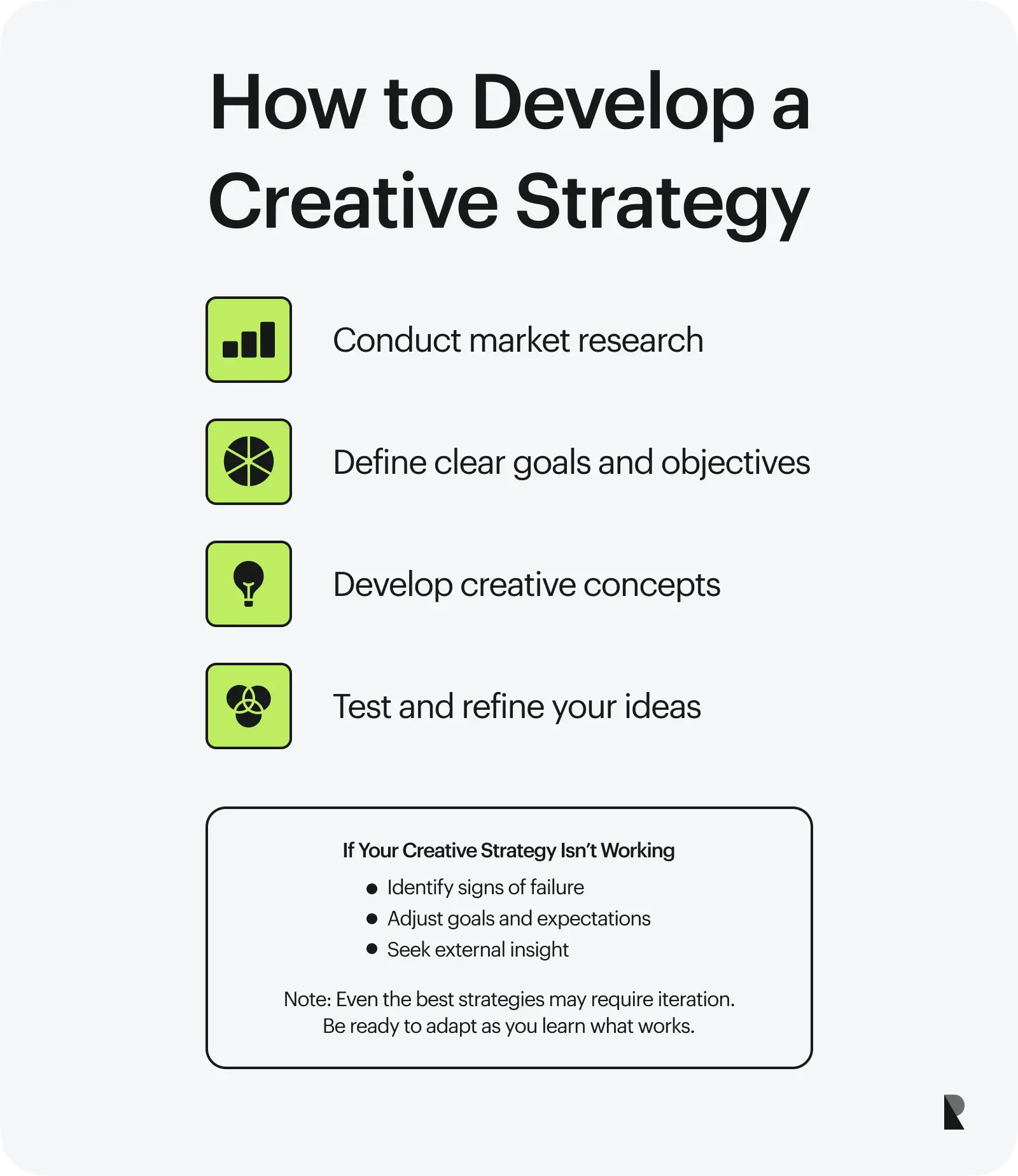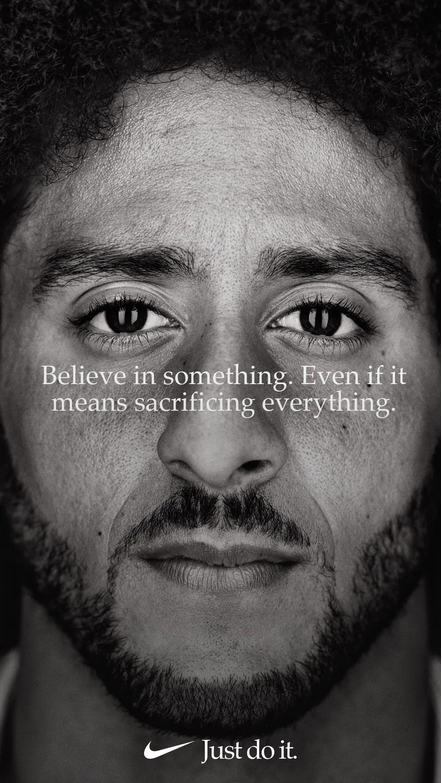Introduction

Have you ever wondered how small businesses outperform their competitors despite limited resources? Often, the secret recipe to their success is a creative strategy. It opens opportunities for the company to increase brand awareness and connect with its audience on a deeper level, turning them into loyal advocates.
According to McKinsey, companies with a high Award Creativity Score (ACS), which measures a brand's creativity based on their marketing campaigns, perform better than their contemporaries. For instance, about 70 percent experienced an above-average increase in their organic revenue growth and total return to shareholders.
Ready to tap your full potential? Learn everything about creative strategy and take your brand to the next level.
It fosters out-of-the-box ideas you can integrate into your marketing campaigns to yield results while optimizing your resources. You can effectively differentiate yourself, communicate value, and engage your audience meaningfully.
Elements of a Creative Strategy
So, what makes up a creative strategy? Let's go through the following essential elements.

Target Audience
Knowing the intended audience of your creative strategy lets you personalize your plan to speak directly to them. It directs you to what you need to know—interests, demands, expectations, behaviors—so you can use the appropriate tools and channels.
Being familiar with your target audience ensures you implement marketing efforts and strategies that are engaging, relevant, and immersive, leading to increased brand recognition, trust, and even higher sales.
Unique Selling Proposition (USP)
Unique Selling Proposition (USP) refers to the quality that sets your business apart. It's also the reason why customers should choose you over other brands.
You can identify your USP by defining your strengths. Think of what your brand is good at—product, pricing, customer service, etc. You can also leverage competitor analysis to determine which gaps your brand can fill. For deeper alignment between market positioning and design execution, consider insights from a brand strategy and design agency that specializes in building cohesive identities from strategy through creative delivery. And look into your feedback pool to understand what customers love about you!
When you can define your USP, you are more likely to focus on developing a creative strategy—ads and marketing collateral—that emphasizes and communicates it to your audience.
Key Brand Messages
Key brand messages are clear statements that tell your customers what makes you unique. These messages may educate, inspire, or pique your audience's interest. Some examples include famous brand slogans like "Think Different" and "Open Happiness" from Apple and Coca-Cola, respectively.
Having a key brand message informs what kind of story and information you need to relay through your creative branding strategy. It also helps align your creative content strategy and other goals, ensuring they deliver consistent messaging.
Visual Style
Getting your visual style right when mapping out your creative strategy ensures an accurate representation of your brand. That said, keep consistency between your marketing efforts and brand identity.
A great example of a brand with a creative strategy that has kept its visual style consistent in its campaigns is McDonald's. It establishes familiarity by using its brand colors and iconic golden arc logo on all its visual collaterals, marketing, and creative content strategy, strengthening brand recognition.
Communication Channels
While there are endless communication channels, it is advisable to stick to the essentials. Doing so ensures your branding and marketing efforts are consistent, effectively sending the message to your intended audience.
Go back to your data and assess which channels your customers frequent. Consider engagement levels and formats appropriate for your brand's creative content strategy. For instance, cosmetics brands perform better on visual-first platforms like Instagram. Remember to tailor your campaigns accordingly when implementing a multi-channel approach.
How to Make a Creative Strategy?
Developing a creative strategy requires tenacity and innovativeness. This is especially true in a highly competitive market. Here are some of the biggest brands that deem a creative strategy essential to their success.
1. Conduct Market Research
Get close and personal with your target audience to understand their desires, interests, and expectations. Consider various market research tools, such as social media listening tools, analytics, surveys, and one-on-one customer interviews.
You should also conduct a competitor analysis to learn about your competitors and industry trends. This process entails running a competitor audit and comparing them with your brand to determine what they're good at and lack. It also includes analyzing their products and overall performance online and offline.
These data are pivotal to the success of your creative branding strategy. But that's just the first step!
2. Set Clear Goals and Objectives for Your Creative Strategy
Having clear objectives ensures that you are working towards a goal. They serve as your team's guide so your creative strategy stays intact.
When setting objectives, ask your creative team the following questions: * What challenges or obstacles are you trying to address? * What are your expectations? * Is your creative marketing strategy in line with your brand values and identity? * What are your metrics for success? * What resources do you need to implement your creative strategy?
These questions help formulate specific objectives that are realistic and attainable.
3. Develop Creative Concepts
Now, it's time to keep the creative juices flowing! But creative concepts aren't something you can wish into existence. Hence, a creative brief is needed.
A creative brief is a document that outlines data about your target audience, key messages, and objectives. It includes a creative strategy statement that serves as a directive to your team. When confusion ensues, everyone can refer to it for guidance.
After that, brainstorming ensues. At this stage, it's best to explore different perspectives by consulting your team and other relevant stakeholders. Try integrating various methods, channels, platforms, and tools. Finally, narrow your creative ideas to those that satisfy the creative brief.
4. Test and Refine Creative Ideas
Your next step is to implement your creative ideas. But before launching, you'll need to test and gather feedback first. This will lessen the likelihood of mistakes and miscommunication and allow you to improve the quality of your advertising campaigns.
Some testing methods you can conduct include:
- A/B testing: Let audience segments compare two versions of a creative collateral to assess which performs better.
- Multivariate testing: Analyze how different versions of creative collaterals with multiple components changed are received by your audience. For example, Ad B differs from Ad A regarding CTA, colors, and images.
- Conversion lift testing: This marketing tool measures the effectiveness of your ad through an experiment. It entails showing one group an ad while the other isn't. The brand will then assess how many bought their products from each group.

What to Do If Creative Strategy Is Not Working
Implementing branding and marketing collaterals can make or break a company. But no one, even big brands, is immune to failure. The best you can do is come prepared. Below are some tips to improve your creative strategy when it's not working.
Recognize When Your Creative Strategy Fails
The quicker you realize your mistakes and failures, the faster you can act on them, wasting less time and resources. Set up parameters and critical indicators to signal when marketing campaigns perform poorly.
Start by tracking engagement trends and negative feedback on social media. Assess the bounce rate on your websites to see if visitors are leaving your page quickly, indicating unmet expectations or poor UI/UX. You can also check whether your efforts are bringing you new customers.
These indicators can identify problems early on so you can conduct an in-depth analysis to assess the situation. This allows timely intervention and adjustment of your creative strategy.
Recalibrate Expectations
Sometimes, we can get too optimistic, leading to unrealistic expectations. Other times, changes happen in the market that we cannot predict.
When the strategy is working against your brand's favor, learn when to fine-tune your expectations to avoid misalignment. This entails reflecting on past failures, comparing past and present outcomes, and communicating changes to your team.
Consult Other Experts
Diverse perspectives often lead to more creative solutions when your strategy is not working. They can highlight gaps that you may have missed and provide alternative viewpoints. You will likely have more explicit guidance on what to do next and better project management when you encourage collaboration in your problem-solving process.
So, in addition to working closely with your creative team, seek feedback and insights from peers, mentors, and industry experts in your network. They may have already encountered similar challenges and be able to offer help.
Examples of Successful Creative Strategies
Nike: “Just Do It” Campaign
Before Nike became famous, it was a small brand trying to break into the industry. But that changed when the brand slogan "Just Do It" was introduced.

Nike’s flagship store in NYC showcases its iconic slogan. Image via Unsplash
Simple and concise, the slogan captured the brand's purpose and tapped into the emotions of its audience. It has elevated the brand from a shop that sells shoes to an inspiration that seeks to "move the world forward through the power of sport."
It is also easy to remember and understand and rolls off the tongue. Drawing from this slogan, Nike released advertising campaigns featuring athletes across all sports—professionals, amateurs, and dreamers. The emotional resonance felt by Nike's target customers has encouraged brand loyalty and advocacy.

Former quarterback Colin Kaepernick graces Nike’s ad. Image via New Yorker
The brand's innovative and flexible creative strategy in the '90s paved the way for its relevance decades after. Athletes like Michael Jordan and Cristiano Ronaldo were proud endorsers of the brand.
Soon enough, Nike's "Just Do It" slogan evolved beyond a slogan to entice buyers. It inspired social activism, proving that the brand is a community of like-minded people.
Dove: “Real Beauty” Campaign
There was a time when conventionally beautiful women—often with gorgeous modelesque features—became the industry standard. Brands have implemented this tactic to play on consumers' insecurities.
Dove was already a trusted brand, but it wanted to change its usual testimony-based advertising campaigns and highlight its less popular products through new creative campaigns. Upon conducting market research, its creative team identified a pattern in which women who looked like fashion models were used in many ads. This tactic has influenced consumers' insecurities to convince them to buy products.
Noticing such a trend, the creative minds behind the Dove "Real Beauty" campaign challenged the narrative. The team studied unconventional types of beauty across cultures and decided to showcase them through the campaign.
Have a look at some of their TV ads below.
The public outpouring of support for the brand created a buzz online and offline. It sparked a conversation about society's unrealistic expectations of women.
Dove's advertisements caused a media storm across the globe, with millions of people watching and sharing them. The brand has won multiple awards from the Cannes Lions Grand Prix Awards and was featured on daytime shows like Ellen.
Twenty years since its launch, Dove continues to reap the benefits of the "Real Beauty" campaign. According to the brand, it has generated €6 billion in sales between 2004 and 2023.
Old Spice: “The Man Your Man Could Smell Like” Campaign
If you're looking for an out-of-the-box creative strategy, check out Old Spice.
Nothing is inspiring about men's deodorant. Men choose products according to convenience and practicality. Hence, the brand decided to put a spin on its creative strategy by marketing its products to women. It made sense, as women are often the ones concerned about the hygiene of their partners.
With this in mind, Old Spice created an ad to make women fall in love. And fell in love they did with an interactive, funny, and engaging ad featuring former NFL athlete Isaiah Mustafa. It hinted at how their men could be like the athlete, too, if they use Old Spice.
Another notable detail is the creative process when filming the ad, which is a feat. The ad was shot in a single take, from the bathroom to the boat and then on a horse!
But did the brand's creative strategy work?
Yes, it did!
Aside from going viral and garnering countless creative awards from advertising bodies, the ad has effectively increased sales for Old Spice's Red Zone Body wash by 60 percent. It has made a name in the industry as one of the most famous campaigns in history.
Build Your Winning Creative Strategy
As the examples above suggest, developing a creative strategy can be crucial to brand success. Effectively harnessed, it can surpass your expectations and continue to be significant decades later.
Of course, developing a creative strategy is easier said than done. That's why you need an innovative team you can trust to ensure a high return on investment.
Oct 4, 2024
